Table of Contents
Time allowed : 3 hours Maximum marks 100
GENERAL INSTRUCTIONS
(i) All questions in both the sections are compulsory.
(ii) Marks for questions are indicated against each.
(iii) Questions No. 1-5 and 17-21 are very short-answer questions carrying 1 nick each. They are required to be answered in one sentence each.
(iv) Questions No. 6-10 and 22-26 are? short-answer questions carrying 3 marks each. Answers to them should normally not exceed 60 words each.
(v) Questions No. 11-13 and 27-29 are also short-answer questions carrying 4 marks each. Answers to them should normally not exceed 70 words each.
(vi) Questions No. 14-16 and 30-32 are long-answers questions carrying 6 marks each. Answers to them should normally not exceed 100 words each.
(vii) Answers should be brief and to the point and the above word limit should be adhered to as far as possible.
SET I
SECTION A
Question.1. What is the relation between Average Variable Cost and Average Total Cost, if Total Fixed Cost is zero?
Answer. If Total Fixed Cost is zero then this implies that Average Fixed Cost is also zero. Then in this case Average Variable Cost will be the same as Average Total Cost i.e., AVC = ATC.
Question.2. A firm is able to sell any quantity of a good at a given price. The firm’s marginal . revenue will be: (choose the correct alternative)
(a) Greater than Average Revenue (b) Less than Average Revenue
(c) Equal to Average Revenue (d) Zero
Answer. (c) Equal to Average Revenue.
Question.3. When does ‘change in demand’ take place?
Answer. Change in demand takes place due to change in the factors other than own price of the gold. These factors include change in the income of consumer, change in the price of substitute goods, favorable change in tastes and preferences etc.
Question.4. Differentiated products is a characteristic of: (choose the correct alternative)
(a) Monopolistic competition only
(b) Oligopoly only
(c) Both monopolistic competition and oligopoly
(d) Monopoly
Answer. (c) Both monopolistic competition and oligopoly.
Question.5. Demand curve of a firm is perfectly elastic under: (choose the correct alternative) 1
(a) Perfect competition (b) Monopoly
(c) Monopolistic competition (d) Oligopoly
Answer. (a) Perfect competition
Question.6. A consumer consumes only two goods X and Y. Marginal utilities of X and Y are 3 and 4 respectively. Prices of X and Y are Rs4 per unit each. Is consumer in equilibrium? What will be further reaction of the consumer? Give reasons.
Answer.

Since the equilibrium condition is not being satisfied, therefore the consumer is not in equilibrium. The given situation represents the following inequality:
\(\frac { { MU }_{ x } }{ P_{ x } } <\frac { { MU }_{ y } }{ { P }_{ y } }\)
Since the consumer is getting more marginal utility per rupee from good Y than from good X, therefore, this will induce the consumer to buy less of X and more of Y. When less of X is purchased/ consumed, \({ MU }_{ x }\) will rise. When more of Y is consumed, \({ MU }_{ y }\) will fall.
The switch over from X to Y will continue till \( \frac { { MU }_{ x } }{ P_{ x } } =\frac { { MU }_{ y } }{ { P }_{ y } }\) and equilibrium is attained.
Question.7. What will be the effect of 10 percent rise in price of a good on its demand if price elasticity of demand is (a) Zero, (b) -1, (c) -2.
Answer. (a) Zero elasticity or perfectly inelastic demand refers to a situation when change in price causes no change in quantity demanded. This means that a 10% rise in price of a good will have no effect on its quantity demanded.
(b) -1. In case of unitary elastic demand, the percentage change in quantity demanded is
equal to percentage change in price. This means that a 10% rise in price of a good will decrease the demand of the good by 10%.
(c) -2. Elasticity greater than one refers to highly elastic demand. This happens when the percentage change in quantity demanded is more than the percentage change in price. Therefore, a 10% rise in price will lead to a decline in demand of the good by 20%.

Question.8. What is Minimum Price Ceiling? Explain its implications.
Answer. See Q. 8, 2015 (I Outside Delhi).
Or
If the prevailing market price is above the equilibrium price, explain its chain of effects.
Answer. If the prevailing market price is more than the equilibrium price, it leads to a situation of excess supply.
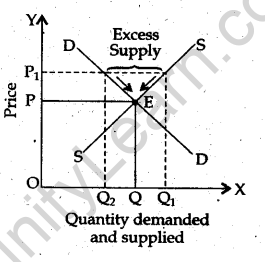
In this situation, if market price is OP1(more than the equilibrium price OP), then it creates excess supply in the market equal to Q1Q2. Excess supply of Q1Q2 will lead to competition amongst sellers as each seller would want to sell his product.
This means that sellers would be ready to charge a lower price to sell their output. With decrease in price, market supply will fall (contraction) and market demand will rise (extension). The price will continue to fall till excess supply is wiped out and equilibrium is attained (as shown by arrows).
Question.9. Define demand. Name the factors affecting market demand.
Answer. Demand for a good is defined as the quantity of a good that a consumer or consumers taken together are willing to buy at a particular price during a particular period of time.
Factors affecting market demand:
(i) Own price of the commodity. Generally, other things remaining constant, demand for a good rises with fall in price and falls with rise in price of that good.
(ii) Population. Higher the number of consumers or total population in a market, higher will be the market demand for a commodity and vice versa.
(iii) Income of the consumers:
(a) Normal goods. Generally,’ increase in the money income of consumers increases the demand for a normal good and a fall in income reduces the demand for it.
(b) Inferior goods. In case of inferior goods, an increase in income reduces the demand for these goods and vice versa.
(iv) Market price of other goods. Quantity demanded of a good also depends upon the market price of other goods (i.e., related goods).
(a) Substitute goods. A rise in price of a substitute good, increases the demand for the given good, and fall in price of substitute good leads to a fall in demand for the given good. Example, tea and coffee.
(b) Complementary goods. Rise in price of a complementary good leads to a fall in demand for the given good and vice versa. Example, tea and milk.
(v) Season and weather. Seasonal and weather conditions also affect consumer’s demand. For example, demand for woollen clothes increases during winters.
Question.10. Define Fixed Cost. Give an example. Explain with reason the behaviour of Average Fixed Cost as output is increased.
Answer. Fixed costs refer to those costs that a firm incurs to employ fixed inputs or factors. For example, cost incurred on plant and equipment, land and building etc.
Average Fixed Cost (AFC) refers to the per unit fixed cost of production. It is derived by dividing Total Fixed Cost by Quantity of output produced.
\( AFC=\frac { TFC }{ Output }\)
AFC falls continuously with rise in output because constant TFC is divided by increasing output. AFC curve is downward sloping and a rectangular hyperbola.
Or
Define Marginal Product. State the behaviour of marginal product when only one input is increased and other inputs ^re held constant.
Answer. Marginal Product is defined as the change in output per unit of change in input when all other inputs are held constant. It is the change in total output brought about by employing one additional unit of variable input.
According to the law of variable proportions, as more and more units of variable inputs are employed with fixed factors, marginal product (MP) first increases, then falls but remains positive and finally becomes negative.
The three phases of the law are:
Phase I: Increasing Returns—MP rises.
Phase II: Diminishing Returns—MP falls but remains positive.
Phase III: Negative Returns—MP becomes negative.
Question.11. When price of a commodity falls from Rs12 per unit to Rs9 per unit, the producer supplies 75 per cent less output. Calculate price elasticity of supply.
Answer.


Question.12. Why do central problems of an economy arise? Explain the central problem of “for whom to produce”?
Answer. The mam reasons for existence of central or economic problems are:
(i) Scarcity of resources. Resources (i.e., land, labour, etc.) are limited in relation to , their demand and economy cannot produce all what people want.
(ii) Unlimited human wants. Human wants are never ending and cannot be satisfied due to limited resources. Also human wants differ in priorities.
(iii) Alternate uses of resources. Resources are scarce and can be put to various alternate uses. This makes choice among resources more important. Therefore, economy has to make choice between the alternative uses of the given resources.
For whom to produce. See Q. 6, 2014 (I Delhi).
Question.13. Explain three properties of indifference curves.
Answer. (i) An 1C slopes downwards from left to right. An indifference curve always slopes downwards to tire right. In other words, it has a negative slope. To consume more of one good, the consumer must give up some quantity of the other good so that total utility remains the same.
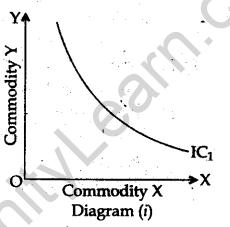
(ii) Higher indifference curve —denotes higher level of satisfaction. This is because higher IC represents more of adeast one commodity, which means more utility as more is preferred to less.
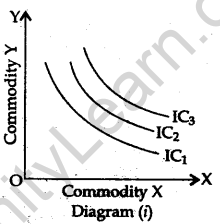
(iii) Two indifference curves never intersect each other because at the point of intersection, the level of satisfaction is the same but at other points it is not the same which is not possible. Therefore, it is wrong to suggest that they intersect as shown in Diagram (iii).

(iv) An IC is convex to the origin. This is because Marginal Rate of Substitution (MRS) declines as more of one good is consumed.
Question.14. Examine the effect of (a) fall in the own price of good X and (b) rise in tax rate on good X, on rile supply curve. Use diagrams.
Answer. (a) Fall in the own price of good X. Fall in price from OP to OPj leads to decrease in quantity supplied from OQ to OQ1 (known as contraction in supply). This results in a downward movement along the same supply curve from point A. to point B.
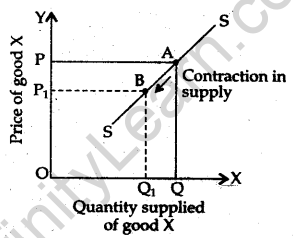
(b)Rise in tax rate on good X. Taxation and subsidy policy of the government also impact market supply of a commodity. Increase in taxation increases the cost of the good, thereby decreasing the supply of the commodity on which the tax has-been levied.
An increase in the tax rate on good X will lead to decline in the supply of X from OQ to OQj resulting in a leftward shift in the supply curve from SS to S1S1. Price remains unchanged.
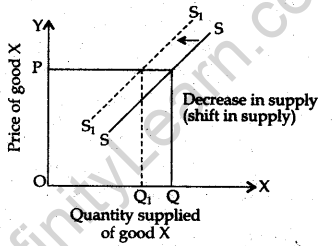
Note: For BLIND CANDIDATES in lieu of Q. No. 14.
Examine the effect of (a) fall in the own price of good X and (b) rise in tax rate on good X on supply of a good. Use schedule.
Answer. (a) Fall in the own price of good X:

When price of good X falls from Rs15 to Rs10, its quantity supplied also decreases from 150 to 100 units.
(b) Rise in tax rate on good X:

Due to increase in tax rate on good X, the supply decreases from 100 to 70 units at the same price of Rs10 per unit.
Question.15. Explain the implications of the following in a perfectly competitive market:
(a) Large number of sellers
(b) Homogenous products.
Answer. (a) Large number of sellers. The number of sellers in a perfectly competitive market is so large that output by an individual seller is an insignificant proportion of the total output of the industry. As such, any change in the output plan of a single producer, assuming no change in output by other producers, has negligible effect on total output and hence no influence on the market price.
(b) Homogenous products. Under perfect competition, firms sell homogenous products, i.e., identical in all respects like size, weight, design, etc. The implication of this feature is that die buyers do not distinguish between the products of different firms. So, they are not ready to pay a different price for the product of any particular firm. Therefore, any attempt by a firm to sell its product at a higher price will fail. This ensures a uniform price for the products of all the firms in the industry.
Or
Explain the implications of the following in an oligopoly market:
(a) Barriers to entry of new firms
(b) A few or a few big sellers
Answer. (a) Barriers to entry of new firms. There are barriers to the entry of new firms in oligopoly industries. These barriers are created largely through patent rights, requirement of huge capital etc. Because of these barriers, the existing firms are not much worried about the entry of new firms in the market. They continue to earn abnormal profits even in the long run.
(b) A few or a-few big sellers. Oligopoly, as an industry, is composed of a few firms or a few large firms controlling the bulk of its output. Since there are a few large firms, each big firm is likely to have a market share big enough to have some influence on the price of the product, the firm produces. Accordingly, the firms are able to generate abnormal profits.
SECTION B
Question.16. Define flows.
Answer. Variables whose magnitude is measured over a period of time are called flow variables. For example, income, expenditure, etc.
Question.17. National income is the sum of factor incomes accruing to: (choose the correct alternative)
(a) Nationals (b) Economic territory
(c) Residents (d) Both residents and non-residents
Answer. (c) Residents
Question.18. What are Revenue Receipts in a government budget?
Answer. The receipts which neither create any liabilities nor lead to any reduction in assets are called revenue receipts.
Question.19. Primary deficit equals: (choose die correct alternative)
(a) Borrowings
(b) Interest payments
(c) Borrowings less interest payments
(d) Borrowings and interest payments both
Answer. (c) Borrowings less interest payments.
Question.20. Foreign exchange transactions which are independent of other transactions in the Balance of Payments Account are called: (choose the correct alternative)
(a) Current transactions (b) Capital transactions
(c) Autonomous transactions (d) Accommodating transactions
Answer. (c) Autonomous transactions.
Question.21. Assuming real income to be Rs 200 crore and price index to be 135, calculate nominal income.
Answer. Real Income = Rs 200 crore, Price index = 135
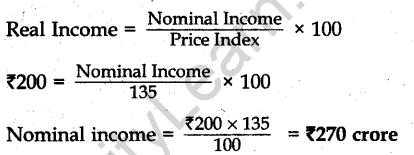
Question.22. What is Aggregate Demand? State its components.
Answer. Aggregate Demand refers to the total value of final goods and services that all sectors of the economy taken together are planning to buy at a given level of income during a period of time. Aggregate demand consists of the following:
(i) Private Final consumption expenditure (C)
(it) Private Investment expenditure (I)
(iii) Government expenditure (G), including government consumption and investment expenditure.
(iv) Net Exports (X – M) i.e., Exports – Imports.
Or
Explain how controlling money supply is helpful in reducing excess demand.
Answer. Excess demand refers to the situation when aggregate demand is in excess of aggregate supply i.e., (AD > AS) corresponding to full employment in the economy.
The central bank controls the supply of money in the economy by regulating the creation of credit by commercial banks. Credit creation by commercial banks in times of excess demand can be controlled by
— increasing the bank rate/ repo rate;
— by selling government securities in the open market to absorb liquidity from the system;
— by increasing CRR and SLR; and
— by raising the margin requirement.
Less money supply i.e., stock of money with people leaves less purchasing power in their hands. Therefore, people demand less goods and services.
Question.23. An economy is in equilibrium. Calculate Marginal Propensity to Consume:
National income =1,000
Autonomous consumption expenditure = 200
Investment expenditure = 100
Answer.

Question.24. Sale of petrol and diesel cars is rising particularly in big cities. Analyse its impact on gross domestic product and welfare.
Answer. Final sale of cars raises GDP, because final sales are final products. Cars provide convenience in transportation and add to the welfare of people. At the same time, rise in sale of petrol and diesel cars particularly in big cities will lead to air pollution and noise pollution which will adversely affect the health of citizens (including children). This is a negative externality occuring because of the smoke and harmful gases being emitted by the vehicles. This leads to respiratory problems and other health issues which will impact the GDP of the nation adversely and reduce the welfare of the people.
Question.25. Explain the ‘medium of exchange’ function of money. How has it solved the related problem created by barter?
Answer. Medium of exchange. Money acts as a medium of exchange for the sale and purchase of goods and services. In the absence of money under the barter system, goods were exchanged for goods. This required double coincidence of wants. Introduction of money has separated the acts of sale and purchase. It allows freedom of choice as every person can buy goods of his choice and also from people offering him the best bargain.
Or
Explain the ‘standard of deferred payment’ function of money. How has it solved the related problem created by barter?
Answer. Standard of deferred payment. Deferred payments refer to those payments which are to be made at some time in the future. In a modem economy, a large number of transactions involve future payments which can easily be stated in terms of money. This is possible because value of money remains more or less constant and it possesses the quality of general acceptability.
In the barter system, it was difficult to make such future payments in terms of goods and services. There was always the risk of the commodity to be repaid increasing or decreasing in value. There could also be a disagreement regarding the quality of goods or services to be repaid.
This function of money has facilitated borrowing and lending activities and promoted trading. It has also led to the creation of financial institutions.
Question.26. Explain how ‘Repo Rate’ can be helpful in controlling credit creation.
Answer. The rate of interest at which the RBI (Central bank) gives short term loans to commercial banks is called Repo Rate.
The Central Bank make use of Repo Rate to control the supply of money and credit creation. A rise in Repo Rate would make borrowings by commercial banks costly. This increase forces these banks to raise the interest rates on lending to the general public. As borrowings from banks become costly, it leads to a decline in demand for borrowings from the banks which decreases credit creation in the economy. Chi the other hand, a fall in Repo Rate encourages banks to keep small proportion of their deposits as reserves since borrowing from Central Bank is now less costly than before. This increases credit creation in the economy.
Question.27. What is the difference between revenue expenditure and capital expenditure? Explain how taxes and government expenditure can be used to influence distribution of income in the society.
Answer. Revenue Expenditure and Capital Expenditure. See Q.-32(b), 2014 (Comptt. I Delhi).
Redistribution of income and wealth. Through its tax and expenditure policy, the ’government attempts to reduce inequalities of income. The government influences the personal disposable income of households by making transfer payments and collecting taxes. In this way, it influences the income distribution in the society. Inequalities of income and wealth can also be reduced through progressive income taxation in which higher the income, higher is the tax rate. Government can impose higher taxes on incomes of the rich and on the luxury goods and services consumed by them. The money so collected can be spent on welfare projects for the poor such as providing free healthcare, free education, subsidies, minimum wages etc. These expenditures by the government will raise the disposable income of the poor.
Or
What is the difference between direct tax and indirect tax? Explain the role of government budget in influencing allocation of resources.
Answer. Direct tax and Indirect tax. See Q. 32(a), 2014 (Comptt. I Delhi).
Allocation of Resources. Government budget is a reflection of certain goals the government wants to achieve. There are many economic activities which are not undertaken by the private sector either due to lack of profits or due to huge investment expenditure involved. Government can undertake these activities on its own. There are many other activities like water supply, sanitation etc. which are necessarily undertaken by government in public interest. In addition, government can encourage the private sector through tax concessions, subsidies etc. to undertake certain production in public interest. By doing so, government helps in influencing allocation of resources.
Question.28. Given saving curve, derive consumption curve and state the steps in doing so. Use diagram.
Answer. See Q.32(Or), 2014 (I Outside Delhi).
Note: For BLIND CANDIDATES in lieu of Q. No. 14 .
Explain Consumption Function. Derive saving function from consumption function.
Answer.Consumption function

Question.29. Indian investors lend abroad. Answer the following questions:
(a) In which sub-account and on which side of the Balance of Payments Account such lending is recorded? Give reasons.
(b) Explain the impact of this lending on market exchange rate.
Answer. (a) Indian investors lending abroad will be recorded in the capital account of the Balance of Payments account on the debit side because it leads to creation of foreign exchange assets. It is recorded on the debit side because it leads to outflow of foreign exchange.
(b) Lending abroad by Indian investors would lead to decrease in the supply of foreign will depreciate.
Question.30. Find Gross National Product at Market Price and Private Income:


Answer.
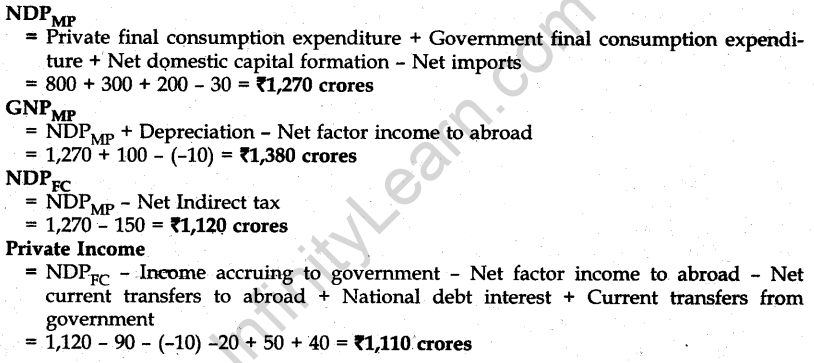
SET II
Note: Except for the following questions, all the remaining questions have been asked in Set-I.
SECTION A
Question.4. When does “change in quantity demanded” take place?
Answer. Change in quantity demanded takes place due to change in price of the commodity itself.
Question.5. What happens to the difference between Average Total Cost and Average Variable Cost as production is increased?
Answer. The difference between Average Total Cost (AC) and Average Variable Cost (AVQ is represented by Average Fixed Cost (AFC) which decreases as production is increased.
Question.7. A consumer consumes only two goods X and Y. Marginal utilities of X and Y are 4 and 3 respectively. Price of X and price of Y is 13 per unit, Is consumer in equilibrium? What will be further reaction of the consumer? Give reasons.
Answer.

Question.9. When price of a good rises from Rs 10 to Rs 12 per unit, the producer supplies 10 percent more. Calculate price elasticity of supply.
Answer.
![]()
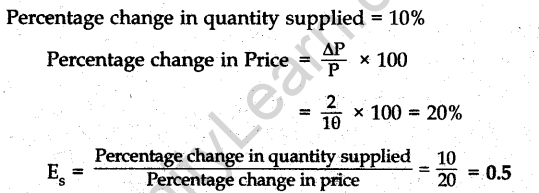
Question.10. Define Utility. Explain the Law of Diminishing Marginal Utility.
Answer. Utility is the amount of satisfaction obtained from consuming goods and services. The law of “diminishing marginal utility” states “as more and more units of a commodity are consumed, marginal utility derived from each successive unit goes on falling”. Ultimately, it may become zero or even negative.
This is because as a consumer consumes more and more units of a commodity, his intensity of want for that commodity goes on falling and a point is reached when he wants no more units of it (as shown in the schedule below).

SECTION B
Question.19. Define Fiscal Deficit.
Answer. Fiscal deficit is the excess of Government total expenditure over Total receipts excluding Borrowings of the government.
Question.21. An economy is in equilibrium. Find investment expenditure: 3
National income = 1,200 ,
Autonomous consumption expenditure = 150 Marginal Propensity to consume =0.8
Answer.

Question.22. If nominal income is Rs 500 and price index is 125, calculate real income.
Answer.

Question.24. Explain the role of Cash Reserve Ratio in controlling credit creation.
Answer. Cash Reserve Ratio (CRR) is the fraction of net total demand and time deposits that commercial banks must keep as cash reserves with the Central Bank, If the Central Bank increases the CRR, the banks are required to hold a larger fraction of their deposits with . the Central Bank. As a result, the lending capacity of the banks decreases which in turn decreases borrowings. This leads to a decline in the credit creation capacity of commercial banks. On the other hand, a credit and money supply will increase.
Question.27. Calculate Net National Product at Market Price and Private income.
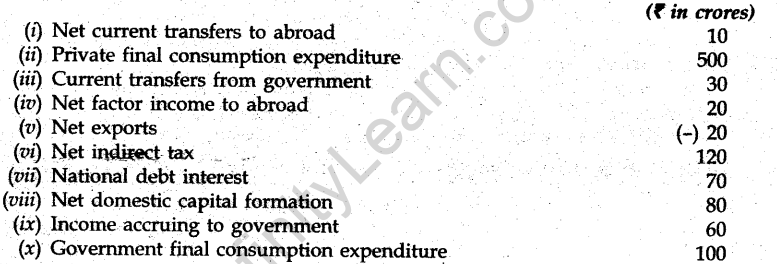
Answer.

SET III
SECTION A
Note: Except for the following questions, all the remaining questions have been asked in Set I and Set II.
Question.3. What happens to the difference between Total Cost and Total Variable Cost as output is increased?
Answer. The difference between Total Cost and Total Variable Cost remains the same as output is increased because this difference is signified by Total Fixed Cost which remains the same, ’ irrespective of the level of output.
Question.5. When does ‘shift in supply curve’ take place?
Answer. Shift in supply curve takes place as a result of change in factors affecting supply other than the own price of the commodity.
Question.8. A consumer consumes only two goods X and Y. The marginal utilities of X and of Y is 3 each. Prices of X and Y are Rs 2 and Rs 1 respectively. Is consumer in equilibrium? What will be further reaction of the consumer? Give reasons.
Answer.

Question.10. When price of a good rises from Rs 8 per unit to Rs 10 per unit, producer supplies 40 units more. Price elasticity of supply is 2. What is the quantity supplied before price change? Calculate.
Answer.

The quantity supplied before the price change is 80 units.
Question.11. Distinguish between individual’s demand and market demand. Name the factors affecting demand for a good by an individual.
Answer. Individual demand for a good is the quantity of Brat good which a consumer is willing to buy at a given price, during a period of time. –
Market demand refers to the total quantity demanded of a commodity by all the consumers at a given pri«e during a period of time. It is derived by adding up the demands of all individual consumers at that price.
TIte factors affecting demand of a good by an individual are:
(i) Price of the commodity itself.
(ii) Prices of related goods—Substitute goods and Complementary goods.
(iii) Income of the consumer—In case of normal and inferior goods.
(iv) Tastes and preferences of the consumer.
SECTION B
Question.20. What are Capital Receipts in a government budget?
Answer. Capital Receipts in a government budget are the receipts that either create a liability (e.g., fresh borrowings) or reduce assets (e.g., disinvestment of PSUs).
Question.22. An economy is in equilibrium. Find investment expenditure:
National Income = 1000
Autonomous Consumption =100 Marginal Propensity to consume = 0.8
Answer.


Question.23. If real income is Rs 400 and price index is 105, calculate nominal income.
Answer.

Question.25. Explain the role of Reverse Repo Rate in controlling credit creation.
Answer. When the commercial banks have surplus funds they can deposit the same with Central Bank of interest paid by the Central Bank on such deposits is called Reverse Repo Rate . When Reverse Repo Rate is increased, it encourages*the commercial banks to deposit more of their funds with the Central Bank. This has a negative effect on the lending capability of commercial banks as it reduces the liquidity of the banks. Thus, this controls credit creation by commercial banks.
Whereas, lowering Reverse Repo Rate has the opposite effect as it increases the credit creation capacity of commercial banks.
Question.29. Calculate National Income and Personal Disposable Income:

Answer.




